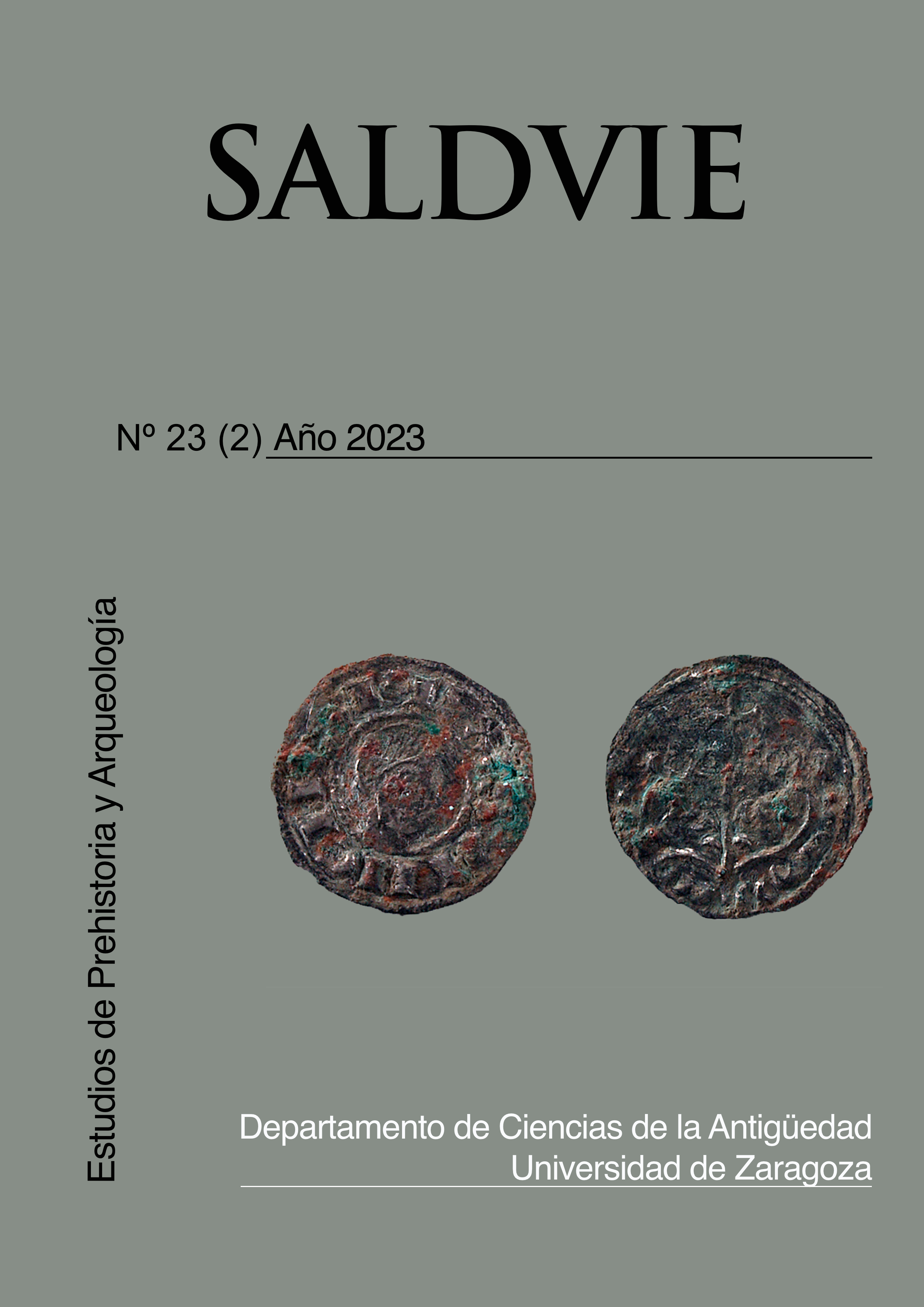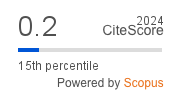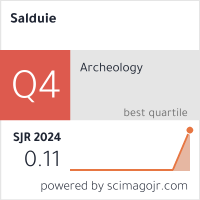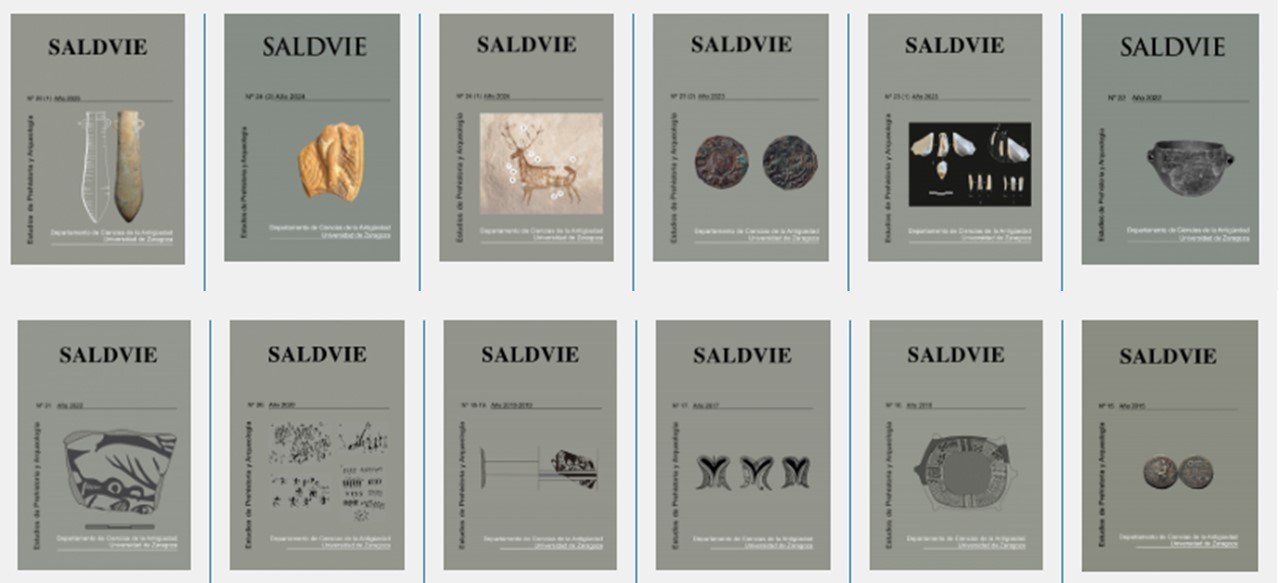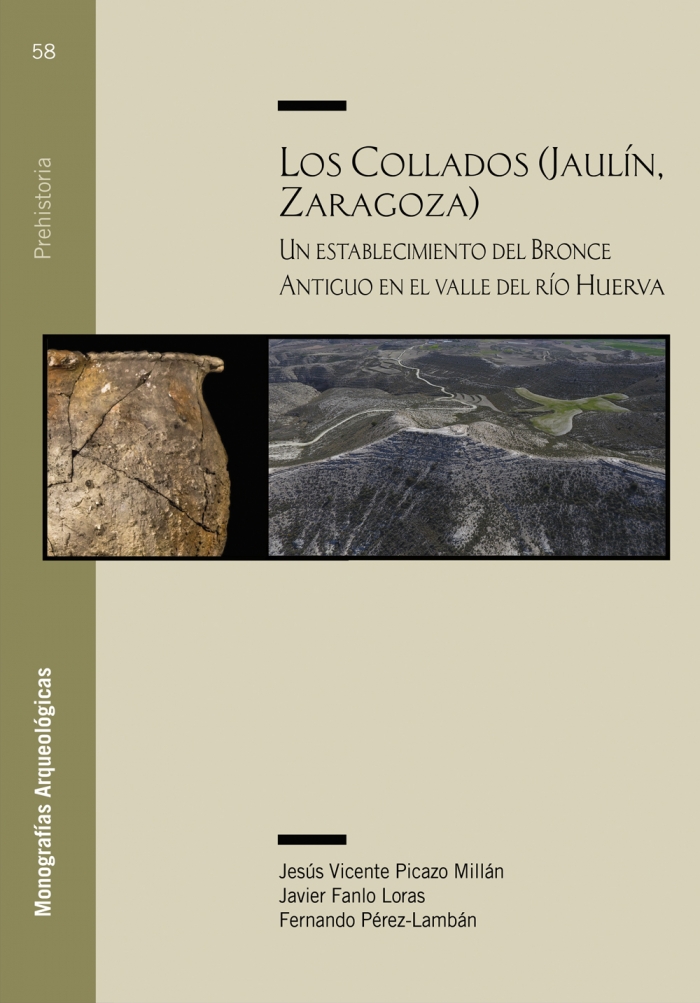Las primeras representaciones rupestres de la región cantábrica desde una perspectiva cognitiva: una aproximación teórica al simbolismo
DOI:
https://doi.org/10.26754/ojs_salduie/sald.202329795Palabras clave:
Arqueología Cognitiva, Arte rupestre, Simbolismo, Comportamiento modernoResumen
La Arqueología Cognitiva utiliza constructos prestados de la Psicología con el fin de analizar el tipo de mente subyacente a las evidencias del registro arqueológico. En este caso se realizará un breve acercamiento a las primeras representaciones gráficas rupestres paleolíticas, caracterizadas por su color rojo y ausencia de figuración, bajo la óptica de las capacidades cognitivas de mayor protagonismo en la mente de los humanos modernos. Para ello se analizará la naturaleza de las capacidades primarias y su combinación en las emergentes, para aplicarlas a las evidencias rupestres. Como conclusión, es posible argumentar que el estilo de algunas representaciones está influenciado por nuestras características neurobiológicas, y que las capacidades cognitivas necesarias para llevar a cabo las representaciones no figurativas más antiguas ya estarían presentes en Homo neanderthalensis.
Descargas
Referencias
Aiello, L. y Wheeler, P. (1995). The Expensive-Tissue Hypothesis: The Brain and the Digestive System in Human and Primate Evolution. Current Anthropology, 36-2: 199-221.
Ardila, A. y Ostrosky-Solís, F. (2008). Desarrollo Histórico de las Funciones Ejecutivas. Revista Neuropsicología, Neuropsiquiatría y Neurociencias, 1: 1-21.
Aubert, M., Brumm, A., Ramli, M., Sutikna, T., Saptomo, E. W., Hakim, B., Morwood, M. J., Van den Bergh, G. D., Kinsley, L., Dosseto, A. (2014). Pleistocene cave art from Sulawesi, Indonesia. Nature, 514: 223-227. https://doi.org/10.1038/nature13422
Aubert, M., Lebe, R., Octaviana, A. A., Tang, M., Burhan, B., Hamrullah, Jusdi, A., Hakim, B., Zhao, J.-X., Geria, I. M., Sulistyarto, P. H., Sardi, R., Brumm, A. (2019). Earliest hunting scene in prehistoric art. Nature, 576: 442-445. https://doi.org/10.1038/s41586-019-1806-y
Aubert, M., Setiawan, P., Oktaviana, A. A., Brumm, A., Sulistyarto, P. H., Saptomo, E. W., Istiawan, B., Ma’rifat, T. A., Wahyuono, V. N., Atkomo, F. T., Zhao, J.-X., Huntley, J., Taçon, P. S. C., Howard, D. L., Brand, H. E. A. (2018). Palaeolithic cave art in Borneo. Nature, 564: 254-257. https://doi.org/10.1038/s41586-018-0679-9.
Baena, J., Carrión, E. (2006). Problemas acerca del final del Musteriense. Zephyrus, 59: 51-66.
Balbín, R., Alcolea, J. J., Alcaraz, M. (2016). The Palaeolithic art of Tito Bustillo cave (Asturias, Spain) in its archaeological context. Quaternary International, 430: 81-96. http://dx.doi.org/10.1016/j.quaint.2016.01.076
Balbín, R., Alcolea, J. J., Alcaraz, M., & Bueno, P. (2022). La Cueva de Tito Bustillo. Ribadesella. Asturias- Ed. Consejería de Cultura, Política Lingüística y Turismo del Principado de Asturias-Impronta. Oviedo.
Bar-Yosef Mayer, D. E., Vandermeersch, B., Bar-Yosef, O. (2009). Shells and ochre in Middle Paleolithic Qafzeh Cave, Israel: indications for modern behavior. Journal of Human Evolution, 56: 307-314. https://doi.org/10.1016/j.jhevol.2008.10.005
Bateson, P. (2004). The active role of behaviour in evolution. Biology and Philosophy, 19: 283–298.
Bednarik, R. G. (2008). The origins of symboling. Signs - International Journal of Semiotics, 2: 82–113.
Benítez Burraco, A. y Longa, V. M. (2011). El papel del ADN fósil en Paleoantropología: FOXP2, neandertales y lenguaje. Zephyrus, LXVII: 45-68.
Bermúdez de Castro, J. M. (2020): La evolución del talento. Cómo nuestros orígenes determinan nuestro presente. Ed. Penguin Random House Grupo Editorial. Barcelona.
Bickerton, D. (1996): Language and Human Behavior, University of Washington Press.
Bogin, B. and Smith, B. H.(1996). Evolution of the Human Li-fe Cycle. American Journal Human Biology, 8: 703-716.
Bouzouggar, A., Barton, N., Vanhaeren, M., D'Errico, F., Collcutt, S., Higham, T., Hodge, E., Parfitt, S., Rhodes, E., Schwenninger, J. L., Stringer, C., Turner, E., Ward, S., Moutmir, A., Stambouli, A. (2007). 82,000-year-old shell beads from North Africa and implications for the origins of modern behavior. PNAS, 104-24: 9964-9969. www.pnas.org/cgi/doi/10.1073/pnas.0703877104
Boyd, R., Richerson, P. J. and Henrich, J. (2011). The cultural niche: why social learning is essential for human adaptation. PNAS, 108-2: 10918–10925, https://www.pnas.org/doi/full/10.1073/pnas.1100290108
Brooks, A., Yellen, J. E., Potts, R., Behrensmeyer, A. K., Deino, A. L., Leslie, D. E., Ambrose, S. H., Ferguson, J. R., D’Errico, F., Zipkin, A. M., Whittaker, S., Post, J., Veatch, E. G., Foecke, K., Clark, J. B. (2018). Long-distance stone transport and pigment use in the earliest Middle Stone Age. Science, 360: 90-94. https://doi.org/10.1126/science.aao2646
Brumm, A., Oktaviana, A. A., Burhan, B., Hakim, B., Lebe, R., Zhao, J.-X., Sulistyarto, P. H., Ririmasse, M., Adhityatama, S., Sumantri, I., Aubert, M. (2021). Oldest cave art found in Sulawesi. Science Advances, 7 : eabd4648. https://doi.org/10.1126/sciadv.abd4648
Bruner, E. (2010). The Evolution of the Parietal Areas in the Human Genus: Between Structure and Cognition. En D. Broadfield, M. Yuan, K. D. Schick, and N. Toth (eds.): The Human brain evolving: paleoneurological studies in honor of Ralph L. Holloway, Stone Gosport, Age Institute Press, 83-96
Bruner, E. and Iriki, A. (2016). Extending mind, visuospatial integrationand the evolution of the parietal lobes in the human genus. Quaternary International 405: 98-110. https://doi.org/10.1016/j.quaint.2015.05.019
Bruner, E. and Lozano, M. (2014). Extended mind and visuo-spatial integration: three hands for the Neandertal lineage. Journal of Anthropological Sciences, 92: 273-280. https://doi.org/10.4436/JASS.92009
Bruner, E., Manzi, G. and Arsuaga, J. L. (2003). Encephalization and allometric trajectories in the genus Homo: Evidence from the Neandertal and modern lineages. PNAS, 100-26: 15335-15340. https://www.pnas.org/doi/full/10.1073/2520pnas.2536671100
Bruner, E., Spinapolice, E., Burke, A.and Overmann, K. A. (2018). Visuospatial Integration: Paleoanthropological and Archaeological Perspectives. Evolution of Primate Social Cognition, Interdisciplinary Evolution Research, 5: 299-326. https://doi.org/10.1007/978-3-319-93776-2_19
Buckner, R.L. and Krienen, F. M. (2013). The evolution of distributed association networks in the human brain. Trends in Cognitive Sciences, 17-12: 648-665. https://doi.org/10.1016/j.tics.2013.09.017
Call, J.and Tomasello, M. (2008). Does the chimpanzee have a theory of mind? 30 years later. Trends in Cognitive Sciences, 12-5: 187-192. https://doi.org/10.1016/j tics.2008.02.010
Cârciumaru, M., Nitu, E.-C., Cîrstina, O. (2014). A geode painted with ochre by the Neanderthal man. C. R. Pale-vol,14:31-41 http://dx.doi.org/10.1016/j.crpv.2014.05.003
Caron, F., d’Errico, F., Del Moral, P., Santos, F.and Zilhão, J. (2011). The Reality of Neandertal Symbolic Behavior at the Grotte du Renne, Arcy-sur-Cure, France. PLoSONE, 6-6: e21545. https://www.doi.org/%2010.1371/journal.pone.0021545
Castellanos, N. (2022). Neurociencia del cuerpo. Cómo el organismo esculpe el cerebro. Ed. Kairos. Barcelona.
Clark, A. (2007). Reinventing Ourselves: The Plasticity of Embodiment, Sensingand Mind. Journal of Philosophy and Medicine, 32-3: 263-282. https://onlinelibrary.wiley.com/doi/10.1111/j.1933-1592.2007.00114.x
Colagè, I.and d’Errico, F. (2020). Culture: The Driving Force of Human Cognition. Topics in Cognitive Science, 12: 654–672. https://doi.org/10.1111/tops.12372.
Cole, J. (2012). The Identity Model: A Theory to Access Visual Display and Hominin Cognition within the Palaeolithic. In Cole, J.and Ruebens, K. (Eds.): Papers from the British Academy Lucy to Language: the Archaeology of the Social Brain Seminar Series on Visual Display in the Palaeolithic. Human Origins, 1, pp. 24-40.
Connor, C. E., Egeth, H. E., Yantis, S. (2004). Visual Attention: Bottom-Up Versus Top-Down. Current Biology, 14: R850-852. https://doi.org/10.1016/j.cub.2004.09.041
Coolidge, F., Overmann, K. (2012). Numerosity, Abstractionand the Emergence of Symbolic Thinking. Current Anthropology, 53(2): 204-225. https://doi.org/10.1086/664818
Corchón, M. S., Garate, D. (2010). Nuevos hallazgos de arte parietal paleolítico en la cueva de La Peña (Candamo). Zephyrus, 66: 75-102.
Corchón, M. S., Gárate, D., Valladas, H., Rivero, O., Pons-Branchu, E., Ortega, P. y Hernando, C. (2014). Back to the point: New data for La Peña de Candamo Cave Art (Asturias). Zephyrus, LXXIII: 67-81. http://dx.doi.org/1 0.14201/zephyrus2014736781
D’Errico, F., Salomon, H., Vignaud, C., Stringer, C. (2010). Pigments from the Middle Palaeolithic levels of Es-Skhul (Mount Carmel, Israel). Journal of Archaeological Science, 37: 3099-3110. http://dx.doi.org/10.1016/j.jas.2010.07.011
D’Errico, F., Vanhaeren, M., Barton, N., Bouzouggar, A., Mienis, H., Richter, D., Hublin, J.-J., McPherron. S. P., Lozouet, P., Klein, R. G. (2009). Additional Evidence on the Use of Personal Ornaments in the Middle Paleolithic of North Africa. PNAS, 106-38: 16051-16056. http://www.pnas.org/cgi/doi/10.1073/pnas.0903532106
Damasio, A. (2003). Feelings of Emotion and the Self. Ann. N. Y. Acad. Sci., 1001: 253-261. https://doi.org/10.1196/annals.1279.014
Damasio, A. (2010). Y el cerebro creó al hombre. Ed. Destino S. A. Barcelona.
Damasio, A. and Carvalho, G. B. (2013). The nature of feelings: evolutionary and neurobiological origins. Natu-re Reviews Neuroscience, 4: 143-152.
Damasio, A., Grabowski, T. J., Bechara, A., Damasio, H., Ponto, L. L. B., Parvizi, J. and Kichwa, R. D. (2000). Subcortical and cortical brain activity during the feeling of self-generated emotions. Nature Neuroscience, 3-10: 1049-1056.
De Andrés, M., & Arrizabalaga, A. (2015). El Paleolítico Superior Inicial en Asturias. en Álvarez, D. (Ed.): Los grupos cazadores-recolectores paleolíticos del occi-den-te cantábrico. Estudios en Homenaje a Francisco Jordá Cerdá en el centenario de su nacimiento. 1914-2014, Entemu XVIII, UNED.
De Salle, R. and Tattersall, I. (2008). Human Origins. What bones and genomes tell us about ourselves. Ed. Texas A&M University Press. College Station (Texas).
Dunbar, R. (2016). Human Evolution. Ed. Oxford University Press. New York.
Eibl-Eibesfeldt, I. (1994). Amor y odio. Historia natural del comportamiento humano. Barcelona, Salvat.
Ferrari, L. P. (2003). Abstraction in mathematics. Phil. Trans. R. Soc. Lond. B, 358: 1225–1230. https://doi.org/10.1098/ rstb. 2003.1316
Fortea, J., Rasilla, M. de la, Rodríguez, V. (2004). L’art pariétal et la séquence archéologique paléolithique de la grotte de Llonín (Peñamellera Alta, Asturies, Espagne). Préhistoire, Art et Sociétés, LIX: 7-29.
Frayer, D. W., Radovčić, J. and Radovčić, D. (2020). Kra-pina and the Case for Neandertal Symbolic Behavior. Current Anthropology, 61-6: 713-731. https://doi.org/10.1086/712088
Gamble, C. (1998). Palaeolithic Society and the Release from Proximity: A Network Approach to Intimate Relations. World Archaeology, 29-3: 426-449.
Gamble, C. (2001). Las sociedades paleolíticas de Europa. Ed. Ariel. Barcelona.
García-Alonso, B., Menéndez, M., Pérez-Diez, S., Maguregui, M. (2022). A study of the artistic corpus of red paintings in El Buxu cave (Cangas de Onís, Asturias, Spain). Journal of Archaeological Science, 45: 103636. https://doi.org/10.1016/j.jasrep.2022.103636
García-Diez, M., Garrido, D., Hoffmann, D. L., Pettitt, P. B., Pike, A. W. G. & Zilhão, J. (2015). The chronology of hand stencils in European Palaeolithic rock art: implications of new U-series results from El Castillo Cave (Cantabria, Spain). Journal of Anthropological Sciences, 93: 1-18. https://doi.org/10.4436/jass.93004
Garofoli, D. (2017). Holistic Mapping: Towards an Epistemological Foundation for Evolutionary Cognitive Archaeo-logy. J Archaeol Method Theory, 24: 1150–1176. https://doi.org/10.1007/s10816-016-9308-9
Gunz, P., Neubauer, S., Falk, D., Tafforeau, P., Le Cabec, A., Smith, T. N., Kimbel, W. H., Spoor, F. and Alem-seged, Z. (2020). Australopithecus afarensis endocasts suggest an ape-like brain organization and prolonged brain growth. Science advances, 6-14: eaaz4729-eaaz4729. https://doi.org/10.1126/sciadv.aaz4729
Gunz, P., Neubauer, S., Golovanova, L., Doronichez, V., Maureille, B., Hublin, J.-J. (2012). A uniquely modern human pattern of endocranial development. Insights from a new cranial reconstruction of the Neandertal new-born from Mezmaiskaya. Journal Human Evolution, 62: 300-313. https://doi.org/10.1016/j.jhevol.2011.11.013
Gunz P., Neubauer S., Maureille B. and Hublin J-J. (2010). Brain development after birth differs between Neanderthals and modern humans. Current Biology. 20: R921–R922. https://doi.org/10.1016/j.cub.2010.10.018
Haidle, M. N. (2010). Working-Memory Capacity and the Evolution of Modern Cognitive Potential: Implications from Animal and Early Tool Use. Current Anthropology, 51: S149-S166. https://doi.org/10.1086/650295
Haidle, M. N. (2012). How to think tools? A comparison of cognitive aspects in tool behavior of animals and during human evolution. Cognitive perspectives in tool behaviour, 1: 1-391.
https://publikationen.uni-tuebin-gen.de/xmlui/handle/10900/49627
Haidle, M. N. (2015). Working-Memory Capacity and the Evolution of Modern Cognitive Potential: Implications from Animal and Early Tool Use. Current Anthropology, 51: S149-S166. https://doi.org/10.1086/650295
Haidle, M. N. (2023). Cognigrams: Systematically Recons-tructing Behavioral Architectures as a Basis for Cognitive Archaeology. In T. Wynn, K. A. Overmann and F. L. Coolidge (Eds.), The Oxford Handbook of Cognitive Archaeology, Oxford Academic. https://doi.org/10.1093/oxfordhb/9780192895950.013.12
Haidle, M. N., Bolus, M., Collard, M., Conard, N. J., Garofoli, D., Lombard, M., Nowell, A., Tennie, C. and Whiten, A. (2015). The Nature of Culture: an eight-grade model for the evolution and expansion of cultural capacities in hominins and other animals. Journal of Anthropological Sciences, 93: 43-70. https://doi.org/10.4436/jass.93011
Henshilwood, C. S., D’Errico, F., Watts, I. (2009). Engraved ochres from the Middle Stone Age levels at Blombos Cave, South Africa. Journal of Human Evolution, 57: 27-47. https://doi.org/10.1016/j.jhevol.2009.01.005
Heyes, C. (2017). When does social learning become cultural learning?. Developmental Science, 20: e12350. https://doi.org/10.1111/desc.12350
Hoffmann, D. L., Angelucci, D. E., Villaverde, V., Zapata, J. y Zilhão, J. (2018a). Symbolic use of marine shells and mineral pigments by Iberian Neandertals 115,000 years ago. Science Advances, 4: eaar5255. https://www.science.org/doi/10.1126/sciadv.aar5255
Hoffmann, D. L., Standish, C. D., García-Díez, M., Pettitt, P. B., Milton, J. A., Zilhão, J., Alcolea-González, J. J., Cantalejo-Duarte, P., Collado, H., […] & Pike, W. G. (2018). U-Th dating of carbonate crusts reveals Neandertal origin of Iberian cave art. Science, 359: 912-915. https://doi.org/10.1126/science.aap7778
Hoffmann, D. L., Standish, C. D., García-Diez, M., Pettitt, P. B., Milton, J. A., Zilhão, J., Alcolea-Gonzalez, J. J., Cantalejo-Duarte, P., Collado, H., de Balbín, R., Lorblanchet, M., Ramos-Muñoz, J., Weniger, G.-C., Pike, A. W. G. Martín-Loeches, M. (2014). Extending the mind, embodying cognition: new light on old endeavours. Journal of Anthropological Sciences, 92: 299-301.
Hoffmann DL, Standish CD, García-Diez M, Pettitt PB, Milton JA, Zilhão J, Alcolea-González JJ, Cantalejo-Duarte P, Collado H, de Balbín R, Lorblanchet M, Ramos-Muñoz J, Weniger GC, Pike AWGn(2020). Response to White et al.,’s reply: “Still no archaeological evidence that Neanderthals created Iberian cave art” [J. Hum. Evol. (2020) 102640]. Journal of Human Evolution, 144: 102810 https://doi.org/10.1016/.jhevol.2020.102810
Holloway, R. (2016). The Evolution of the Hominid Brain. In W. Henke, I. Tattersall (eds.): Handbook of Paleoan-thro-pology. https://doi.org/10.1007/978-3-642-39979-4_81
Hovers, E., Ilani, S., Bar-Yosef, O., Vandermeersch, B. (2003). An Early Case of Color Symbolism. Current Anthropology, 44-4: 491-522.
Hublin, J. J. and Changeux, J. P. (2022). Paleoanthropology of cognition: an overview on Hominins brain evolution. Comptes Rendus Biologies, 345-2: 57-75. https://doi.org/10.5802/crbiol.92
Kaplan, H., Hill, K., Lancaster, J., Hurtado, A. M. (2000). A Theory of Human Life History Evolution: Diet, Intelligence and Longevity. Evolutionary Anthropology, 9-4: 156-185. https://doi.org/10.1002/1520-6505
Krause, J., Lalueza-Fox, C., Orlando, L., Enard, W., Green, R. E., Burbano, H. A., Hublin, J.-J., Hänni, C.; Fortea, J., De La Rasilla, M., Bertranpetit, J., Rosas, A. y Pääbo, S. (2007). The derived FOXP2 variant of modern humans was shared with Neandertals. Current Biology, 17: 1908-1912. https://doi.org/10.1016/j.cub.2007.10.008
Laland, K. and Seed, A. (2021). Understanding Human Cog-nitive Uniqueness. Annu. Rev. Psychol, 72: 689–716. https://doi.org/10.1146/annurev-psych-062220-051256
Learey, M. R. and Buttermore, N. R. (2003). The Evolution of the Human Self: Tracing the Natural History of Self-Awareness. Journal for the Theory of Social Behaviour, 33-4: 365–404. https://doi.org/10.1046/j.1468-5914.2003.00223.x
Lieberman, D. E. (2008). Speculations About the Selecti-ve Basis For Modern Human Craniofacial Form. Evolutionary Anthropology, 17: 55–68.
Lieberman, D. E., McBratney, B. M. and Krovitz, G. (2002). The evolution and development of cranial form in Homo sapiens. PNAS, 99-3: 1134–1139. www.pnas.org/cgi/doi/10.1073pnas.022440799
Lombard, M. and Gärdenfors, P. (2017). Tracking the evo-lution of causal cognition in humans. Journal of Anthropological Sciences, 95: 219-234. https://doi.org/10.4436 / j ass.95006
Lombard, M. and Gärdenfors, P. (2021): “Causal Cognition and Theory of Mind in Evolutionary Cognitive Archaeology”, Biological Theory. https://doi.org/10.1007/s13752-020-00372-5
Maclarnon, A and Hewitt, G. (2004). Increased breathing control: another factor in the evolution of human language. Evolutionary Anthropology, 13: 181–197. https://doi.org/10.1002/evan.20032
Malafouris, L. (2011). How Things Shape the Mind. Ed. The MIT Press. Cambridge, Mass.
Marean, C. W., Bar-Matthews, M. B., Bernatchez, J., Fisher, E., Goldberg, P., Herries, A. I. R., Jacobs, Z., Jerardino, A., Karkanas, P., Minichillo, T., Nilssen, P. J., Thompson, E., Watts, I., Williams, H. M. (2007). Early human use of marine resources and pigment in South Africa during the Middle Pleistocene. Nature, 449: 905-908. https://doi.org/10.1038/nature06204
Marquet, J.-C., Freiesleben, T. H., Thomsen, K. J., Murray, A. S., Calligaro, M., Macaire, J.-J., et al.,. (2023). The earliest unambiguous Neanderthal engravings on cave walls: La Roche-Cotard, Loire Valley, France. PLoS ONE, 18-6: e0286568. https://doi.org/10.1371/journal.pone.0286568
Martín-Loeches, M. (2008). La mente del “Homo sapiens”. Ed. Santillana Ediciones Generales S.L. Madrid.
Martínez-Villa, A. (2018). Arte paleolítico cantábrico. Signos y símbolos: Los signos como indicadores gráficos de territorio y territorialidad. El caso del valle del Sella en la comarca oriental asturiana, (Tesis doctoral inédita). http://e-spacio.uned.es/fez/view/tesisuned:ED-PgHHAT-Amartinez
Menéndez, M. (2016). Arte rupestre paleolítico en la Cueva del Buxu (Asturias, España), en el centenario de su des-cubrimiento. Cuadernos de Arte Prehistórico, 2: 7-31.
Ménendez, M. (2014). Desde Candamo a la cueva del Pindal: un siglo de estudios del arte Paleolítico en Asturias. En Álvarez Alonso, D. (Ed.): Los grupos de cazadores-recolectores paleolíticos del occidente cantábrico. Estudios en Homenaje a Francisco Jordá Cerdá en el centenario de su nacimiento. UNED. Gijón.
Moya-Albiol, L. (2010). Bases neuronales de la empatía. Rev Neurol; 50-2: 89-100. https://doi.org/10.33588/rn.5002.2009111
Neubauer S., Gunz P. and Hublin J-J. (2010). Endocranial shape changes during growth in chimpanzees and humans: a morphometric analysis of unique and shared aspects. J. Hum. Evol. 59: 555–566. https://doi.org/10.1016/j.jhevol.2010.06.011
Pascual-Leone, A., Amedi, A., Fregni, F. and Merabet, L. B. (2005). The Plastic Human Brain Cortex. Annu. Rev. Neurosci., 28: 377-401. https://doi.org/10.1146/annurev.neuro.27.070203.144216
Peresani, M., Vanhaeren, M., Quaggiotto, E., Queffelec, A., d’Errico, F. (2013). An Ochered Fossil Marine Shell From the Mousterian of Fumane Cave, Italy. PLoS ONE, 8-7: e68572. https://doi.org/10.1371/journal.pone.0068572
Pike, A. W. G., Hoffmann, D. L., García-Díez, M., Pettitt, P. B., Alcolea, J., Balbín, R., González-Sainz, C., De Las Heras, C., Lasheras, J. A., Montes, R., & Zilhão, J. (2012). En los orígenes del arte rupestre Paleolítico: dataciones por la serie del Uranio en las cuevas de Altamira, El Castillo y Tito Bustillo. En De Las Heras, C. et al. (Coords.): Pensando el Gravetiense: nuevos datos para la región cantábrica en su contexto peninsular y pirenaico, Monografías del Museo Nacional y Centro de Investigación de Altamira, n.º 23, Ministerio de Educación, Cultura y Deporte, 461-475.
Ponce de León, M. S., Bienvenu, T., Marom, A., Engel, S., Tafforeau, P., Alatorre Warren, J. L., Lordkipanidze, D., Kurniawan, I., Bayu Murti, D., Adi Suriyanto, R., Koesbardiati, T. and Zollokofer, C. P. E. (2021). The primitive brain of early Homo Science, 372: 165–171. https://doi.org/10.1126/science.aaz0032
Ponce de León, M. S. Bienvenu, T., Akazawa, T. and Zol-likofer, C. P. E. (2016). Brain development is similar in neanderthals and modern humans”, Current Biology, 26: R641-R666. https://doi.org/10.1016/j.cub.2016.06.022
Quam, R., Martínez, I., Rosa, M., Bonmatí, A., Lorenzo, C., de Ruiter, D. J., Moggi-Cecchi, J., Conde Valverde, M., Jarabo, P., Menter, C. G., Thackeray, J. F. and Arsuaga, J. L. (2015). Early hominin auditory capacities”, Science Advances, 1-8. https://doi.org/10.1126/sciadv.1500355
Ramírez Rozzi, F. V. and Bermúdez de Castro, J. M. (2004). Surprisingly rapid growth in Neanderthals. Nature; 428-6986: 936-939.
Ripoll, S., Bayarri, V., Castillo, E., Latova, J. & Muñoz-Ibáñez, F. J. (2015). El Panel de las Manos de la Cueva de El Castillo (Puente Viesgo, Cantabria). En Lasheras, J. A.; Fatás, P., Agúndez, M., De Miguel, L. (Coords.): International Rock Art Conference, IFRAO 2015, Cáceres, AKREOS, 2015, pp. 2275-2290.
Rivera, Á. y Menéndez, M. (2012). Las conductas simbólicas en el Paleolítico. Un intento de comprensión y análisis desde el estructuralismo funcional. Espacio, Tiempo y Forma. Serie I, Nueva época. Prehistoria y Arqueología, t. 4: 11-42.
Rivera, Á. y Menéndez, M. (2023). Manual de Arqueología y Paleoantropología Cognitivas. Ed. UNED. Madrid.
Rivera, Á. y Rivera, S., (2018). Estudio transdisciplinario sobre la autoconciencia. Ludus Vitalis XXV, 48: 1-24
Roebroeks, W., Siera, M. J., Nielsen, T. K., De Loecker, D., Parés, J. M., Arps, C. E. S. and Mücher, H. J. (2012). Use red ochre by early Neandertals. PNAS, 109-6: 1889 -1894. www.pnas.org/cgi/doi/10.1073/pnas.1112261109
Rosas, A., Ríos, L., Estalrrich, A., Liversidge, H., García-Tabernero, A., Huguet, R., Cardoso, H., Bastir, M., La-lueza Fox, C., de la Rasilla, M., Dean, C. (2017). The growth pattern of Neandertals, reconstructed from a juvenile skeleton from El Sidrón (Spain). Science, 357: 1282-1287. https://doi.org/10.1126/science.aan6463
Rossano, M. J. (2010). Making Friends, Making Tools and Making Symbols. Current Anthropology, 51-1: S89-S98. https://doi.org/10.1086/650481
Sánchez-Cubillo, I., Tirapu Ustárroz, J. y Adrover-Roig, D. (2012). Neuropsicología de la cognición social y la autoconciencia. En Tirapu, J., García, A., Ríos, M. y Ardila, A. (Ed.). Neuropsicología del cortex prefrontal y funciones ejecutivas. Ed. Vigueral. Barcelona.
Santiago, J., Tornay, F., Gómez, E. and Elosúa, R. M (2006). Procesos Psicológicos Básicos. Ed.McGraw Hill. Madrid.
Straus, L. G. (2005). A mosaic of change: the Middle-Upper Palaeolithic transition as viewed from New Mexico and Iberia. Quaternary International, 137: 47-67. https://doi.org/10.1016/j.quaint.2004.11.019
Straus, L. G. (2020). Neanderthal last stand? Thoughts on Iberian refugia in late MIS 3. Journal of Quaternary Science, 37-2:1-8. https://doi.org/10.1002/jqs.3252
Stuart-Fox, M. (2015). The origins of causal cognition in early hominins. Biology & Philosophy, 30: 247-266. https://doi.org/10.1007/s10539-014-9462-y
Tattersall, I. (2009). Becoming modern Homo sapiens. Evo Edu Outreach: 584–589. https://doi.org/10.1007/s12052-009-0164-x
Tirapu-Ustárroz J., Luna-Lario, P., Iglesias-Fernández, M. D., Hernáez Goñi. P. (2011). Contribución del cerebelo a los procesos cognitivos: avances actuales. Rev Neurol, 53: 301-15. https://doi.org/10.33588/rn.5305.2010747
Tomasello, M. (2007). Los orígenes culturales de la cognición humana. Ed. Amorrortu. Buenos Aires.
Tulving, E. (2002). Episodic Memory: From Mind to Brain. Annu. Rev. Psychol., 53: 1-25.
Villa, P., Roebroeks, W. (2014). Neandertal Demise: An Archaeological Analysis of the Modern Human Superiority Complex. PLoS ONE, 9-4: e96424. https://doi.org/10. 1371/journal.pone.0096424
White, R., Bosinski, G., Bourrillon, R., Clottes, J., Conkey, M. W., Corchon Rodriguez, M. S., Cortes-Sánchez, M., de la Rasilla Vives, M., Delluc, B., Delluc, G., Feruglio, V., Floss, H., Foucher, P., Fritz, C., Fuentes, Ó., Garate, D., Gonzalez Gómez, J., Gonzalez Morales, M. R., Gonzalez Pumariega Solis, M., Groenen, M., Jaubert, J., Aran-zazu Martinez Aguirre, M., Medina Alcaide, M. Á., Moro Abadia, Ó., Ontañón Peredo, R., Paillet-Man-Estier, E., Paillet, P., Petrognani, S., Pigeaud, R., Pinçon, G., Plas-sard, F. E., Ripoll Lopez, S., Rivero Vila, O., Robert, E., Ruiz-Redondo, A., Ruiz Lopez, J. F:, San Juan-Foucher, C., Sanchidrián Torti, J. L., Sauvet, G., Simon Vallejo, M. D., Tosello, G., Utrilla, P., Vialou, D., Willis, M. D. (2020). Still no archaeological evidence that Neanderthals created Iberian cave art. Journal of Human Evolution, 144: 102640. https://doi.org/10.1016/j.jhevol.2019.102640
Wynn, T. and Coolidge, F. L. (2014). Technical cognition, working memory and creativity. Pragmatics & Cognition, 22-1: 45–63. https://doi.org/10.1075/pc.22.1.03wyn
Zilhão, J. (2012). Personal Ornaments and Symbolism A-mong the Neanderthals. Developments in Quaternary Science, 16: 35-49.
Zilhão, J., Angelucci, D. E., Badal-García, E., d’Errico, F., Daniel, F., Dayet, L., Douka, K., Higham, T. F. G., Mar-tínez Sánchez, M. J., Montes Bernárdez, R., Murcia Mascarós, S., Pérez Sirvent, C., Roldán García, C., Vanhaerenk, M., Villaverdec, V., Wood, R. and Zapata, J. (2010). Symbolic use of marine shells and mineral pig-ments by Iberian Neandertals. PNAS, 107-3: 1023-1028. http://www.pnas.org/cgi/doi/10.1073/pnas.0914088107
Descargas
Publicado
Número
Sección
Licencia
Derechos de autor 2024 Salduie

Esta obra está bajo una licencia internacional Creative Commons Atribución-NoComercial-SinDerivadas 4.0.
SALDUIE conserva los derechos patrimoniales (copyright) de los artículos publicadas, autorizando a usar, difundir, transmitir y exponer públicamente su contenido, siempre que se cite la autoría, la url y la revista, y no se use para fines comerciales. También se reserva el derecho de la reproducción de los artículos en copia impresa, formato de documento portátil (.pdf) o ediciones HTML de JoS. Los autores están de acuerdo con la licencia de uso utilizada por la revista, al igual que con las condiciones de autoarchivo y su política de acceso abierto.
